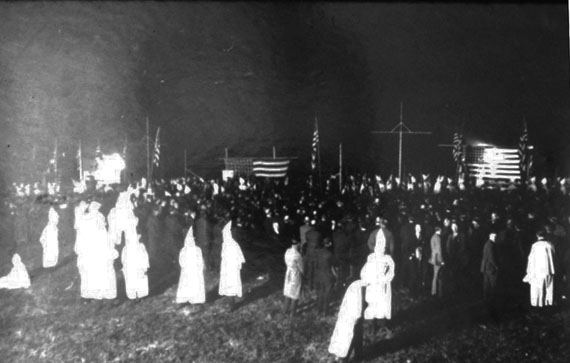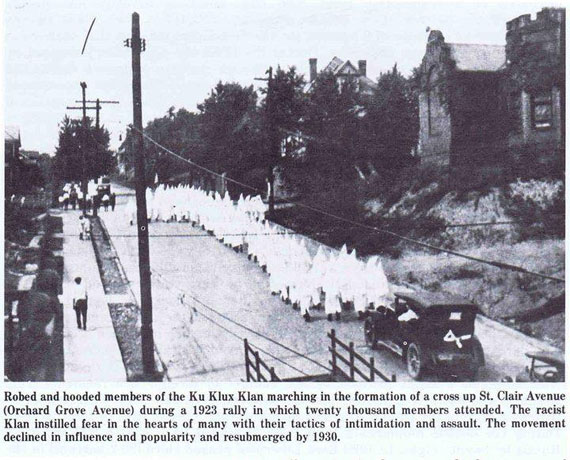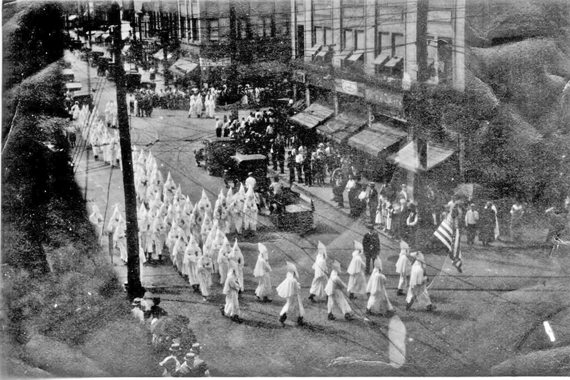The anti-immigrant attitude of many Americans during this period contributed to the resurgence of the Ku Klux Klan. Re-formed in 1915, the Klan vowed to maintain white supremacy and Anglo-Saxon purity. The Klan opposed Blacks, Jews, Catholics, immigrants, and liquor. Appealing to certain native-born rural and working class Protestants looking for a means to cope with the disillusionment and anxiety created by the changing times, the Klan prospered during the early 1920's. By mid-decade it had an estimated four to five million members and wielded strong influence and "frightening power" in several areas of the south and midwest. The Klan first emerged in the East Liverpool area in September of 1922 with the appearance of a flaming cross on Deidrick's Hill in the Northside. The greatest weapon of the Klan was the secret nature of the organization. They could parade, intimidate, and assault without anyone knowing exactly who they were, only what they represented. People became afraid to resist them or to talk against them. In October of 1923 Mayor J.S. Wilson granted the Klan a permit for a parade and a pageant in the city. During the ensuing conclave, an estimated twenty thousand Knights of the Ku Klux Klan from the tri-state district met on the Sanford Fisher farm north of the city. 39
The Klan began a drive in Chester and Newell to prevent certain merchants from operating their shops on Sundays in violation of West Virginia blue laws. The Reverend E.V. Huffer, a Klan leader in Hancock and Brooke counties, sent letters warning them to close. A sign in the grocery store of Ildebrando Ciccerelli on Caroline A venue in Chester read, "Closed on account of a dead friend - Mrs. Liberty." When others did not comply Huffer filed charges, but the Hancock County Grand Jury did not grant indictments. Huffer announced that the Klan would continue its drive despite the decision. Chester became the home of the first junior order of the KKK in West Virginia in October of 1923 when several members of the junior group from East Liverpool initiated thirty-five boys into the order. The Klan was so active in Chester that A.C. Blair founded the "A.C. Blair Klan Plate Company" which purchased blank plates from local potteries and decorated them with a variety of Klan motifs including a burning cross and a hooded Knight on horseback.40
In East Liverpool the Klan was especially active in the east end where many of the city's black and Italian residents lived. Hooded members entered factories and told bosses to get rid of any Italian workers: The Klan also broke in doors and searched houses without warning looking for liquor. The police did nothing, one witness said, because the Klan was too strong and several of them were members. In November of 1923 the KKK celebrated the election of Charles Brown as mayor of East Liverpool with a parade of about twenty-five cars and a cross burning. In July of 1924 the Klan held an initiation at Rock Springs Park and burned several crosses while the Knights of the Flaming Circle, an organization opposed to the group, held a ceremony on the hillside above East Liverpool and burned a ten-foot circle. The following day an estimated five thousand people attended a Klan picnic at the park after a parade through the city. Following this notice in the Review, activities of the Ku Klux Klan disappear from the pages of the local press. By 1930 the influence and popularity of the Klan had waned because of poor leadership and the lack of generally acceptable objectives. Failing to achieve substantive results, it became largely an underground organization locally and nationally.41 The City of Hills and Kilns -- CHAPTER 7 - 1910-1930-276-78
"CIRCA" 1925 Funeral Procession
These first 8 pictures are courtesy of the Salem Historical Society.

In the diamond.
.jpg)
.jpg)
Front below the North Side Fire Station.
.jpg)
Just above the North Side Fire Station.
.jpg)
In the cemetery.
.jpg)
.jpg)
.jpg)
Taken Passing the North Side Fire Station coming back down.

Suppose to be Fisher Park area. Jack Lanam Slide

A picture like one from the SHS with a different description from Te City of Hills and Kilns.

From Jack Lanam slides looking back further down 6th Street.
This site is the property of the East Liverpool Historical Society.
Regular linking, i.e. providing the URL of the East Liverpool Historical Society web site for viewers to click on and be taken to the East Liverpool Historical Society entry portal or to any specific article on the website is legally permitted.
Hyperlinking, or as it is also called framing, without permission is not permitted.
Legally speaking framing is still in a murky area of the law though there have been court cases in which framing has been seen as violation of copyright law. Many cases that were taken to court ended up settling out-of-court with the one doing the framing agreeing to cease framing and to just use a regular link to the other site.
The East Liverpool Historical Society pays fees to keep their site online. A person framing the Society site is effectively presenting the entire East Liverpool Historical Society web site as his own site and doing it at no cost to himself, i.e. stealing the site.
The East Liverpool Historical Society reserves the right to charge such an individual a fee for the use of the Society’s material.